

 Vol. 39 (# 15) Year 2018. Page 31
Vol. 39 (# 15) Year 2018. Page 31
Zarina VALIKHANOVA 1
Received: 18/11/2017 • Approved: 15/12/2017
2. Fundamental approaches to defining the concept of quality
3. The approaches to the concept of quality defined by the time
5. Quality management of education at the state level
6. Education quality management Processes
7. Criteria for assessing the quality of education
8. A matrix of criteria for assessing the quality
9. An environment creation of quality education
10. Formation model of the environment quality of education
11. Analysis of Higher Education in the Republic of Kazakhstan
12. Quality Assessment Parameters RK universities
ABSTRACT: This article addresses the problem of defining quality in educational sphere. Taking into account different approaches of scientists and specialists, alternative approaches to the quality of education concept and its assessment are determined. The most significant criteria for the formation of the matrix assessment and quality control is highlighted to further enhance the quality of education in universities. In the article, the example shows an environment of quality where proper policy of the University can be analyzed and formulated taking into account the market situation. The article also discusses the current situation in the market of educational services of the Republic of Kazakhstan, based on the data, it is proposed to consider the quality of the indexes formed on the basis of market conditions. |
RESUMEN: Este artículo aborda el problema de definir la calidad en el ámbito educativo. Teniendo en cuenta los diferentes enfoques de científicos y especialistas, se determinan enfoques alternativos del concepto de calidad de la educación y su evaluación. Se destacan los criterios más importantes para la formación de la evaluación matricial y el control de calidad para mejorar aún más la calidad de la educación en las universidades. En el artículo, el ejemplo muestra un entorno de calidad donde la política adecuada de la Universidad puede analizarse y formularse teniendo en cuenta la situación del mercado. El artículo también analiza la situación actual en el mercado de servicios educativos de la República de Kazajstán, sobre la base de los datos, se propone considerar la calidad de los índices formados sobre la base de las condiciones del mercado. |
In modern conditions, one of the priority issues of development is the constant improvement of quality. Quality management issues affect all spheres and areas of human activity.
In the process of quality education management, multiple criteria for an educational institution is considered, the estimation of which determines the result of organization's performance. The concept quality of education itself relates more to the philosophical aspect, as knowledge, not determined by specific values that contribute to an objective assessment.
In many scientific studies, more attention is paid to the quality of management processes and system assessments in the issue of education quality.
Estimated parameters and criteria in the educational system show quantitative characteristics of data. Quantitative indicators are important for an objective evaluation, in this regards, it is necessary to consider a large amount of data at both macro and micro levels. Thus, the process of evaluation, monitoring and quality control becomes costly for educational institutions.
Questions of quality management in institution lie in the plane of efficiency search of the quality management process and the search for objective technology assessments of the quality management system.
Technology assessment of education quality is concluded in the quality management control functions. The quality management function is an important activity, but as practice shows, not always effective.
With regard to the effectiveness of the process, there is a need to consider quality management issues comprehensively, starting with an assessment of the external environment.
Today, active development of marketing communications determines the trend, the transition of universities to be open. Society can monitor and provide an objective assessment of a particular educational institution. For stakeholders it is an additional criterion for assessing the quality, it is a landmark for the students in the choice of an educational institution.
Quality is a characteristic of the product (service), therefore management of educational institutions need to pay more attention to market aspects of quality management, rather than to the functional ones.
Determining quality of product (service) depends on various aspects and conditions of its formation. The most obvious form of quality of the product category is expressed in the technical aspect (characteristic of the good), where quality is attributed to the quantitative and qualitative characteristics.
From an economic point of view, it is important to know how the quality management processes are cost-effective for educational institution. In the legal aspect, quality serves as a set of object properties that meet the requirements established in the normative and technical documentation (Mishin, 2005).
The quality as an engine is determined by the growth of needs and human motivation. In the future, the ultimate goal of motivation pyramid (Kenrick D.T., 2010), the quality is a certain finish line in each stage of the growth of human needs. Each stage requires satisfaction of needs at a high quality level, after which growth and transition to the next stage takes place.
Each product (service) includes a variety of properties and together make up the quality. For specific characteristics of quality products, out of all variety of properties, only those are considered that currently are of interest to the consumer (Govers P.C., 2005) or benefit (Drucker, 2007).
Thus, the concept of quality is not determined by specific quantities or formulations, in this article, we highlight the following: quality is related to performance management processes, assessment of specific indicators, the degree of satisfaction of specific human needs, growth factor.
During the industrial growth the concept of quality was given two aspects, on the one hand the subject had objective physical characteristics, on the other hand the object was estimated subjectively according to the degree of "good" or "bad" (Shewhart, 1931).
Other researchers adhere to the concept of quality as the degree of need satisfaction of the consumer products (Ishikawa, 1990), (Juran, 1992).
In practice, the quality of the product (service) is considered as one of the main thing, the dominant property, and most vividly characterizes an object. All other properties of the product (service) that are less important, are not taken into account. This facilitates the task of managing quality, by abstracting from certain properties of a product (services).
A different perception of the concept of quality is explained by the fact that the quality is the first principle of material and non-material world and therefore in principle cannot be determined. It can not be analyzed, it is the final substance (Ciarrochi, et al., 2001).
Figure 1
Understanding of quality
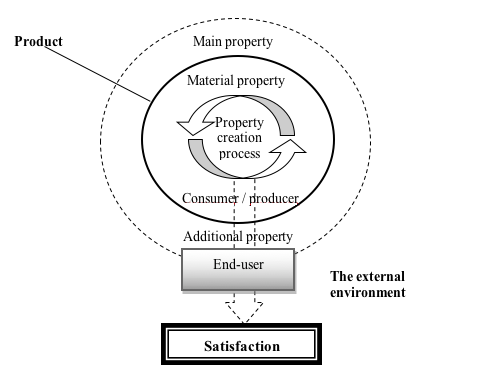
Thus, we distinguish two main approaches to the definition of quality. The first approach involves the measurement of physical properties, parameters and characteristics of the product (services), while the second approach defines mental quality assessment form product (service).
The results of quality management, we see in the consumption of products or services, in the evaluation of the company, etc. In the short and medium term, we observe aligned quality management process and receive feedback in the form of increased profit margins and other indicators. The main problems are beginning to arise in long-term planning. When developing strategy of enterprise, we define the vector of the quality of the product (service). Quality as a standard cannot be lowered due to low demand or product sales. In this regard, the important role of quality management system in the enterprise shall be noted. This system is designed to regulate quality management processes of the enterprise, taking into account market situation.
Founders of quality management are considered to be E. Deming (Deming, 1982), J. Juran (Juran, 1992), A. Feigenbaum (Feigenbaum, 1977), as well as the Shewhart (Shewhart, 1931) and Crosby (Crosby, 2014), etc. Many researchers have developed its own quality management theory, many of which are used in practice. The development concept of quality management, we can provide in the form of a table (see Figure 2).
Figure 2
Stages of development of quality management
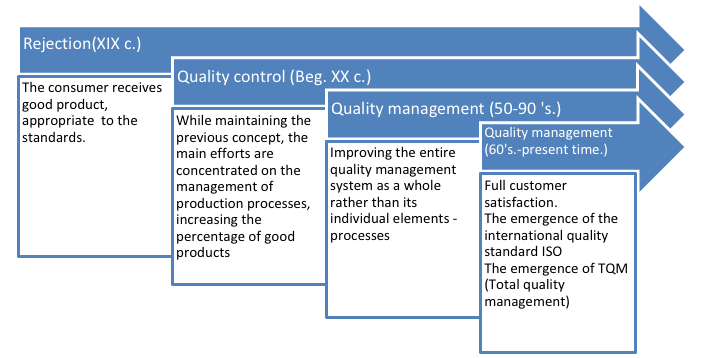
Quality management is not a separate discipline and as a rule, it is a function of every business management process. Moreover, when considering project management, it is impossible to implement a successful project without quality as it is the part of the trio factors (Atkinson, 1999).
Thus, we determine that quality management is an integral process of enterprise / project management. Therefore, quality management is necessary to refer to the profit center of enterprise, because usually the quality of the products (services) is a factor in consumer choice (Sprotles & Kendall, 1986).
Development of concepts shows that many of the management issues, technology and quality management tools remain open. It is necessary to revise and supplement the factors in assessing the quality, control and monitoring for taking objective management decision in quality management.
Practice shows that the economic development of countries, the level and quality of education is fully consistent with the standard of living and other macroeconomic indicators. Education quality management in different countries is formed both centrally and locally. In the centralized form of management, the management of the quality of education is delivered at the system level. This leads in most cases to the unification of education for "weak" educational institutions and is affected positively.
Education quality management system can be "flexible" or "hybrid". The system's flexibility allows to segment the industry subjects and define quality assessment levels. Segmentation of the subjects (Morey, 2004), can also be segmented by level and by all the parameters of the educational process that will allow educational institution to effectively manage quality management processes.
Hybrid quality management system is similar to the portfolio management system projects. The state institutions have leaders in technology, law, economics, etc. where they are given all possible assistance in order to increase competitiveness at the international level. Subsequently, these enterprises leaders will be sort of a domestic benchmark for other institutions.
Centralized management allows you to effectively monitor and control the activities of all subjects. This control system is effective in the short and medium term development. For strategic planning of improving quality of education, management should be to localized the to the level of subject industry.
Process ensuring the continuous improvement of the quality of higher education is based on the concept of isolation ("the quality loop" (Deming, 1982). The formation of processes should be determined by the quality of education strategy.
The processes of quality control of higher education are integrated into a single macro system, which includes components such as:
In the formation of the quality of education management process, it is necessary to consider and use modern tools of management, control and monitoring.
The process of evolution should take place by the concept of a smooth transition in order to analyze the effectiveness of previous and subsequent processes.
The effectiveness of quality management processes should include the parameters and criteria for evaluating not only the growth of education level and qualification of the subjects of education, but also the growth of the actual profit from the quality management.
A large number of criteria of quality assessment are combined into groups (Torrance, 2007). The complexity of the evaluation is concluded in determining the value and interdependence between the criteria. The evaluation of criteria is performed taking into account static and dynamic data of the universities.
Formation of the criteria for assessing the quality of education should contribute to effective decision-making in the quality management process. Assessment criteria have their own levels.
At macro level, criteria of quality evaluation affect top management of higher education. Top management builds infrastructure of the University, forms a system of incentives for all entities of the University, and creates efficient processes.
At micro level, subjects of the quality system create a unique methodology, program and control the quality of the exchanged knowledge. The exchange of knowledge takes place at teachers and students level, it is necessary to have an established electronic generating and knowledge-sharing system.
Today, teachers play the role of project managers. The project is teaching the course, and the result of certain achievements of students, which together should create some value not only for the teacher and the student, but also for the University
Criteria for knowledge assessment needs to be developed based on market trends. It is necessary to focus not only on standards but also on market forces of supply and demand.
For the purpose of efficient approach to monitoring the quality of higher education system development, it is necessary to create matrix criteria. Matrix (Table 1) helps to identify causes and factors affecting a particular level of quality. The matrix criteria can be linked to a benchmark and to set certain parameters for each subject of the quality system.
Table 1
Quality criteria matrix
Quality criteria |
Levels of quality |
||||
Low level |
Medium level |
Above average |
High level |
PRO |
|
Content of education |
Educational plans and programs |
Compliance with educational plan and program standards |
Compliance of programs to market trands |
Availability of own teaching material |
Availability of professional programs |
Staff |
IT skills |
Qualification |
Availability of methodological development |
Creativity |
Ability to lead |
Technologies |
General methods |
Conducting lectures and seminars examinations and testing |
Conducting laboratory and practical works |
||
Technical support |
Classes equipped with PC Presence of required software |
Presence of network and access to information |
Availability of integrated management systems |
||
Results |
Intermediate control |
Results of examinations |
Development of discipline |
Final exams |
Level of employment |
This matrix is useful for determining at what level is the quality of one direction or criteria groups and what level should correspond to other groups of criteria.
If the content of education is at the highest level, respectively, the personnel should possess creative potential, which contributes to the use or conduct of laboratory and field practical work. Further, communication networks shall be available and free access to information (possibly via the Internet) and libraries, together this should be reflected in a high level of final exam.
An environment creation of quality education is based on the concept of the market environment of the enterprise (Kotler, 2000). Each environment influences the formation and understanding of the required quality of the university.
Standard criteria for the quality assessment displays proposed values of environment subject of the University. The University is the backbone of the subject of socio-economic development of the state. To build a quality system of education effectively, it is necessary to control the values of internal and external environment.
Environmental analysis can give more information, to what direction quality of education shall be developed. Today, technological direction of education development is one of the directions, which means getting closer to student’s practice, in this regard, we see the active development of business incubators and techno parks in the structure of universities.
The model shows the overall quality of education environment, each university can have different model, but in most cases, the model will have the following view.
Figure 3
The quality of education environment
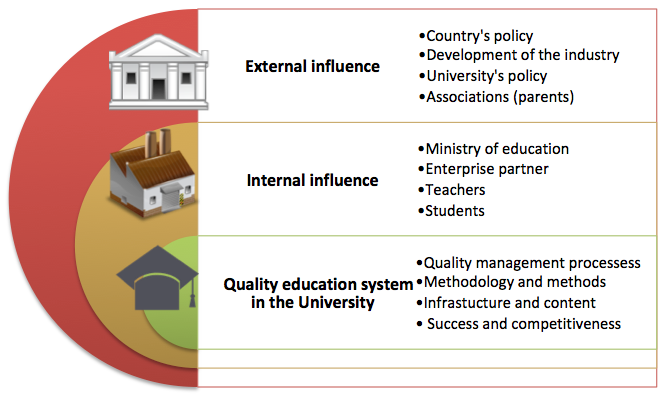
The environment analysis can give more insights to the management to what direction quality of higher education should be developed. It should be noted that for narrow-profile or technical specialties may have additions to the quality of environment.
Methods of formation and the analysis is as follows. Each circle has its own criteria and parameters.
Market approach to education quality management is the satisfaction of all concerned parties.
The priority task for public universities is to assess the quality of government departments and meet their standards, and policy implementation. Private universities are aimed at satisfying students and their parents. If the lines connected by the parties concerned, in both cases, we see the wrong circles and placed centers of gravity in quality management respectively.
This approach will identify and monitor effective policies for improving the quality of education management system.
At the end of the 90’s, the number of universities and institutions has reached more than 180 (Commitee on Statistics, 2015). This indicator looks illogically, especially when you consider that, by the end of the 90’s the economy of Kazakhstan showed a decline.
In the early 2000s, the state had taken measures to tighten requirements for licensing of educational activities, which led to a reduction in higher educational institutions. Currently, there are 149 commercial universities, and the number is decreasing every year.
Figure 4
Status of education development in Republic of Kazakhstan
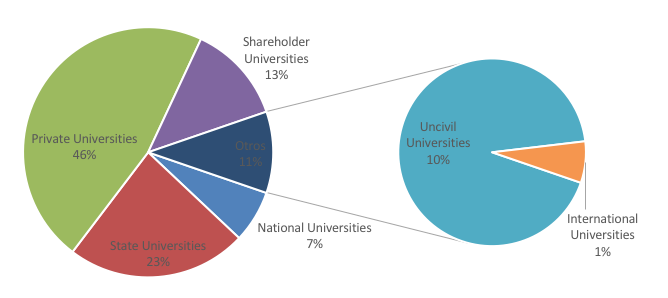
Mainly commercial universities are preparing specialists of humanities such as economics, law. This specialization was the most popular in the '90s, and therefore, the proportion of humanities specialists in Kazakhstan exceeded the technical, on the other hand, of the labor market conditions corresponded the development of the humanities.
The quality of education is estimated by the result of the University activities and services provided. Each university develops its own pricing policy. Usually the cost of training corresponds to the quality of education. Based on this, we have formed indicators and indexes of quality based on the data value, the number of faculty and number of students of.
To begin, let’s consider the performance cost of education and number of students (Fig.4). The list of universities are presented in the ranking by cost for education that are included in the TOP 10 [2]. Given the location of universities according to the ranking value, the measure of the number of students is variable, which suggests that cost is not the determining
factor when choosing University. The greatest number of students are enrolled in national and public universities.
Figure 5
The cost of education and the number of students
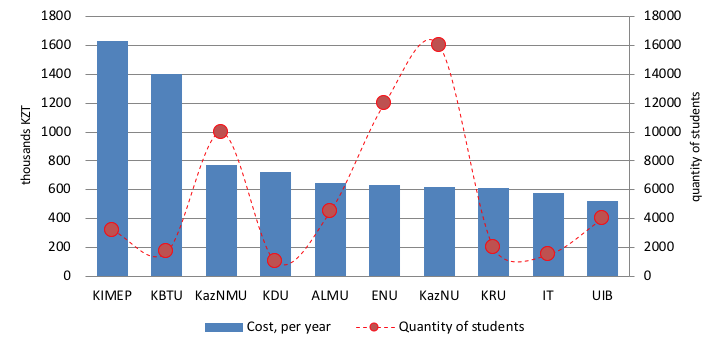
TOP 10 Universities [2]
Then, we formed the first index, which is determined by two factors - the number of students for 1 teacher and, accordingly, the cost of education in this University. (Fig.5)
Figure 6
The University Quality Indexes
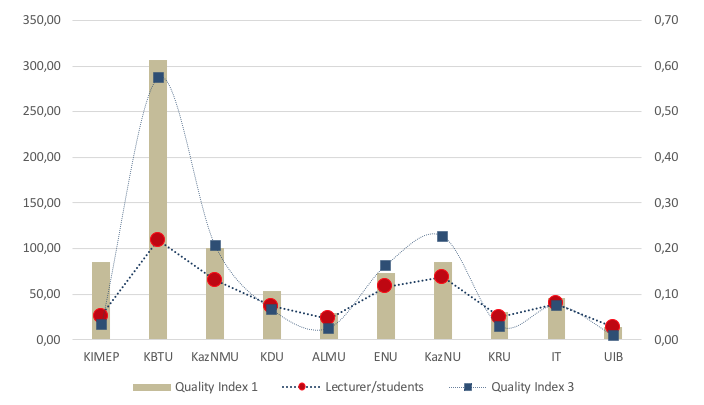
TOP 10 Universities [2]
According to the first index, KBTU is ahead of analyzed objects, by almost 3 times. This analysis shows the status of quality considering the index number of students per teacher. The more students in the university, the less attention is paid to quality in learning, especially private universities, where the main policy of the company is built on the constant increase in the number of students.
The second quality index is formed on the basis of the total amount of state funds allocated to one teacher. Thus, we determine the value of the University for the teaching staff. Senior Specialist chooses where to work, given the values that will be received from the university. Teachers and scientists are the important ones in the process of formation of the quality of education.
Figure 7
Number of teachers and quality index
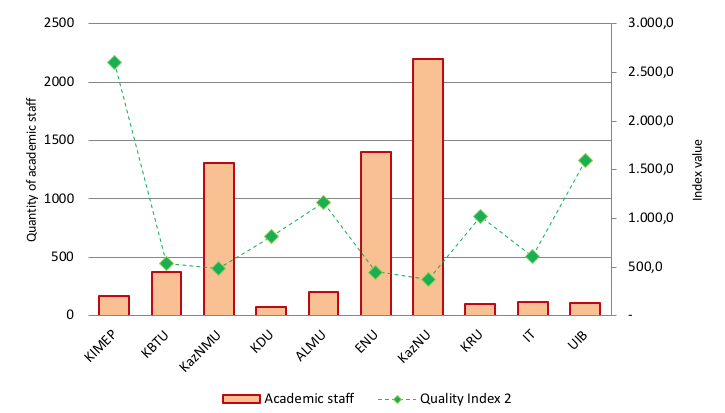
TOP 10 Universities [2]
The largest number of teachers is in national universities, however, the value they represent is not high. Private universities show a high value because the universities pay more attention to the qualitative growth of teachers.
The third quality index (Figure 5) - is the ratio of the first and second indexes. The purpose of the calculation of the third quality index is determined by objective approach. As a result, we see that the national universities show a sufficient level of quality. One of the most important aspects you need is to consider the number of teachers.
Accreditation, as in the domestic conditional state of faculty is considered, determining the number of hours / credits. Highly qualified teachers and scientists have greater efficiency in research activities than their use in teaching. Thus, based on a simple matrix of price and quality, we see that private institutions are not in a competitive situation.
In this article, we defined the concept of quality, which is as close as possible to the conditions of the higher education system functioning. The concept of quality itself includes many aspects and only technical parameter is determined according to the properties and characteristics as compared with other object. The quality of education can be determined by the economic growth of the country; however, the economy depends on many factors. In this regard, the approximate definition of quality can serve the needs of concerned parties.
To improve the effectiveness of quality management it is necessary to develop simple not complex models, analysis and control. In this regard, the proposed model quality matrix can serve as a kind of monitoring to determine the quality level of its further development. Moreover, this matrix may be applicable in local and global modes.
When forming the desired quality, it is necessary to analyze the concerned parties in improving the quality, their actions and visions in the quality of management process, which directly determines the policies and the concept of quality of education at the University.
The market situation of education in Kazakhstan shows a unique case. On the one hand, in quantitative aspect, Kazakhstan has achieved some progress (more than 95% of the population have higher education), on the other hand, innovation does not appear and GDP growth is not so swift.
Exploring the leading universities of the country, we have formed a quality indexes based on the market conditions of education and have identified certain patterns.
In Kazakhstan, there is a lack of highly specialized teachers and scientists, on the one hand to ensure an even load of students per teacher, on the other hand to ensure the growth of research and results.
Atkinson, R., 1999. Project Management: cost, time and quality, two best guesses and a phenomenon, it's time to accept other succes criteria. International journal of project management, 17(6), pp. 337-342.
Ciarrochi, J., Forgas, J. P. & Mayer, J. D., 2001. Emotional intelligence in everyday life: A scientific inquiry. s.l.:Psychology Press.
Commitee on Statistics, 2015. Operational data (express information, bulletins), Education, Astana: Commitee on Statistics of the Republic of Kazakhstan.
Crosby, P., 2014. Quality is Free: The Art of Making Quality Certain. s.l.:McGraw-Hill.
Deming, W., 1982. Quality productivity, and competitive position. Boston: Massachusetts Institute of Technology, Center for Advanced Engineering Study.
Drucker, P. F., 2007. Management challenges for the 21st centure. s.l.:Routledge.
Feigenbaum, A. V., 1977. Quality and Productivity. Quality Progress, Issue November, pp. 18-21.
Govers P.C., S. J., 2005. Product personality and its influence on consumer preference. Journal of Consumer Marketing, Issue 22(4), pp. 189-197.
Ishikawa, K., 1990. Introdustion to quality management. s.l.:Productivity Press.
Juran, J. M., 1992. Juran on quality by design: the new steps for planning quality into goods and services. s.l.:Simon and Schuster.
Kenrick D.T., G. V. N. S. S. M., 2010. Renovating the pyramid of needs contemporary extensions built upon ancient foundations. Perspectives on psychological science, Issue 5(3), pp. 292-314.
Kotler, P., 2000. Marketing management. 9 ed. s.l.:Prentice Hall International.
Mishin, V. M., 2005. Quality management. 2nd edition ed. Moscow: IuNITI-DANA.
Morey, A. I., 2004. Globalization and the emergence of for-profit higher education. Higher Education, 48(1), pp. 131-150.
Sangeeta Sahney, D. B. S. K., 2008. Conceptualizing total quality management in higher education. The TQM Magazine, Vol. 16(Iss: 2), pp. 145 - 159.
Sârbu, R., Ilie, A. G., Enache, A. C. & Dumitriu, D., 2009. The quality of educational services in higher education–assurance, management or excellence. Amfiteatru Economic, 9(26), p. 385.
Shewhart, W. A., 1931. Economic control of quality of manufactured product. Newtown: ASQ Quality Press.
Sprotles, G. B. & Kendall, E. L., 1986. A methodology for profiling consumers' decision‐making styles. Journal of Consumer Affairs, 20(2), pp. 267-279.
Torrance, H., 2007. Assessment as learning? How the use of explicit learning objectives, assessment criteria and feedback in post‐secondary education and training can come to dominate learning. Assessment in Education, 14(3), pp. 281-294.
1. Al-Farabi Kazakh National University, Almaty Kazakhstan
2. Deciphering names of universities:
KIMEP – Kazakhstan Institute of Management, Economic and Planning.
KBTU – Kazakh-British Technical University (now – Kazakh National Research and Technical University).
KazUI&IL - Kazakh National University of International affairs & Foreign Languages.
KDU – Kazakh – Deutche University.
ALMU – Almaty Management University.
ENU – Eurasian National University named by Gumilev.
KazNU – Kazakh National University named by al-Faraby.
KRIU – Kazakh-Russian International University.
IU of IT – International University of Information Technology.
UIB – University of International Business.